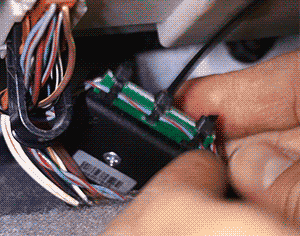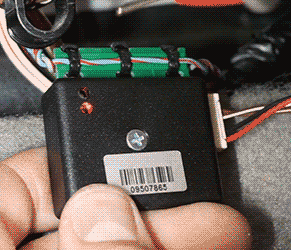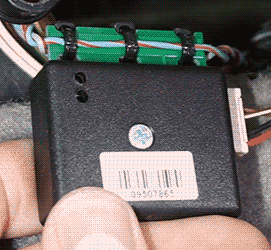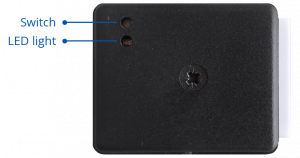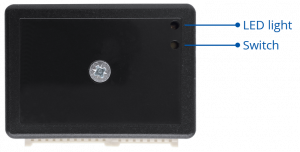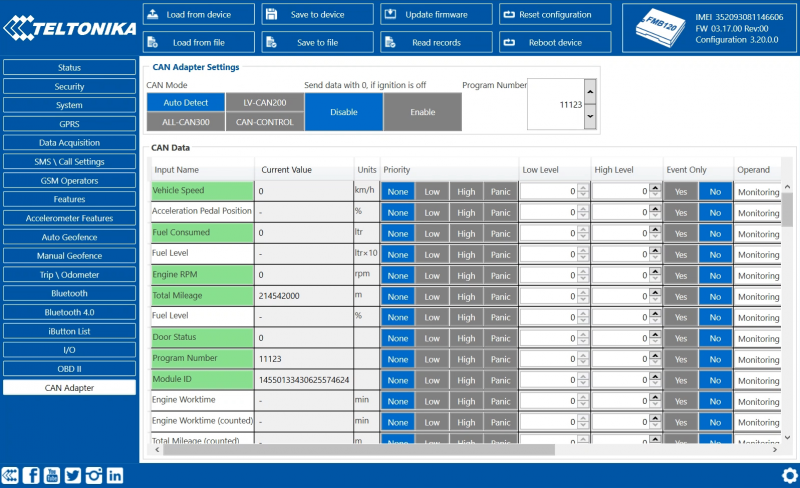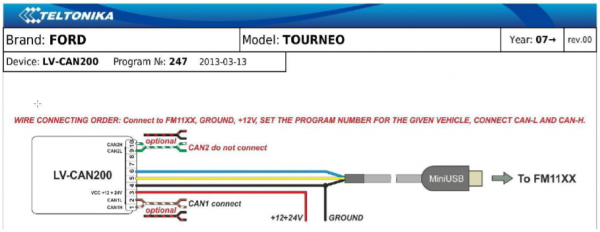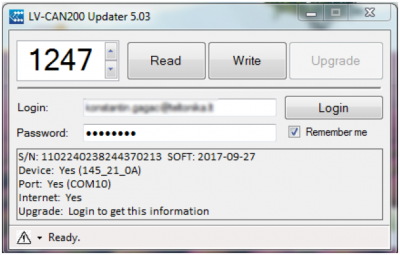Difference between revisions of "Template:FMU CAN adapters FMU125"
(Created page with "Easy steps to install and configure following CAN adapters on {{{model|FMU125}}} device: * LV-CAN200 * ALL-CAN300 * CAN-CONTROL * SIMPLE-CAN __TOC__ ==Insta...") |
|||
| (4 intermediate revisions by 2 users not shown) | |||
| Line 4: | Line 4: | ||
* [[CAN-CONTROL]] | * [[CAN-CONTROL]] | ||
* [[SIMPLE-CAN]] | * [[SIMPLE-CAN]] | ||
| − | + | ||
__TOC__ | __TOC__ | ||
| Line 32: | Line 32: | ||
# Configure CAN adapter to read CAN bus data or control vehicle by setting its '''program number''' - [[{{{model|FMU125}}}_CAN_adapters#CAN_Adapter_Configuration|CAN Adapter configuration]] | # Configure CAN adapter to read CAN bus data or control vehicle by setting its '''program number''' - [[{{{model|FMU125}}}_CAN_adapters#CAN_Adapter_Configuration|CAN Adapter configuration]] | ||
<br /> | <br /> | ||
| − | [[File: | + | [[File:CAN_adapter_connection_example.png|1000px|none|thumb|LV-CAN200/ALL-CAN300 connection example. This is not a connection diagram for your vehicle. Every vehicle has a specific scheme.]] |
| − | [[File:Can- | + | [[File:Can-control_connection_example.png|1000px|none|thumb|CAN-CONTROL connection example. This is not a connection diagram for your vehicle. Every vehicle has a specific scheme.]] |
<br /> | <br /> | ||
===Installing LV-CAN200/ALL-CAN300 + SIMPLE-CAN=== | ===Installing LV-CAN200/ALL-CAN300 + SIMPLE-CAN=== | ||
| Line 63: | Line 63: | ||
# Configure CAN adapter to read CAN bus data by setting its '''program number''' - [[{{{model|FMU125}}}_CAN_adapters#CAN_Adapter_Configuration|CAN Adapter configuration]] | # Configure CAN adapter to read CAN bus data by setting its '''program number''' - [[{{{model|FMU125}}}_CAN_adapters#CAN_Adapter_Configuration|CAN Adapter configuration]] | ||
<br /> | <br /> | ||
| − | [[File:Can_adapter%2Bsimple- | + | [[File:Can_adapter%2Bsimple-can_connection_example.png|1000px|none|thumb|LV-CAN200/ALL-CAN300 + SIMPLE-CAN connection example. This is not a connection diagram for your vehicle. Follow LV-CAN200/ALL-CAN300 connection scheme suitable for your vehicle.]] |
<br /> | <br /> | ||
==CAN Adapter Configuration== | ==CAN Adapter Configuration== | ||
| Line 103: | Line 103: | ||
CAN adapter program number can be set via '''[[Teltonika Configurator]] → (1) CAN Adapter → (2) Program Number'''. When program number is entered press [[File:Save_to_device.png|25px|link=]] '''(3) Save to device''' button that saves the entered program number into {{{model|FMU125}}}. | CAN adapter program number can be set via '''[[Teltonika Configurator]] → (1) CAN Adapter → (2) Program Number'''. When program number is entered press [[File:Save_to_device.png|25px|link=]] '''(3) Save to device''' button that saves the entered program number into {{{model|FMU125}}}. | ||
<br/><br/> | <br/><br/> | ||
| − | [[Image: | + | [[Image:Can adapter conf.png|700px]] |
<br/><br/> | <br/><br/> | ||
| − | |||
====Entering manually==== | ====Entering manually==== | ||
---- | ---- | ||
| Line 149: | Line 148: | ||
The CAN Adapter I/O element can be configured like any other I/O element in [[Teltonika Configurator]]. All information about I/O element parameters description is in section [[{{{model|FMU125}}} I/O settings|I/O settings]]. | The CAN Adapter I/O element can be configured like any other I/O element in [[Teltonika Configurator]]. All information about I/O element parameters description is in section [[{{{model|FMU125}}} I/O settings|I/O settings]]. | ||
<br /> | <br /> | ||
| − | [[Image: | + | [[Image:Fmb120_can_conf_example.png|800px|none]] |
<br /> | <br /> | ||
When using offline configuration method user can select which CAN data (according to vehicle) will be sent directly to the server without connection to adapter. | When using offline configuration method user can select which CAN data (according to vehicle) will be sent directly to the server without connection to adapter. | ||
| Line 308: | Line 307: | ||
|} | |} | ||
<br /> | <br /> | ||
| + | |||
====SMS Configuration==== | ====SMS Configuration==== | ||
---- | ---- | ||
| Line 343: | Line 343: | ||
| style="border: 1px solid white; border-bottom: 2px solid #E8E8E8; text-align: left; vertical-align: center; background: white;" | Yes | | style="border: 1px solid white; border-bottom: 2px solid #E8E8E8; text-align: left; vertical-align: center; background: white;" | Yes | ||
|- | |- | ||
| − | | style="border: 1px solid white; border-bottom: 2px solid #E8E8E8; text-align: left; vertical-align: center; background: white;" | [[ | + | | style="border: 1px solid white; border-bottom: 2px solid #E8E8E8; text-align: left; vertical-align: center; background: white;" | [[FMU lvcangetinfo|lvcangetinfo]] |
| style="border: 1px solid white; border-bottom: 2px solid #E8E8E8; text-align: left; vertical-align: center; background: white;" | Get information about connected CAN Adapter | | style="border: 1px solid white; border-bottom: 2px solid #E8E8E8; text-align: left; vertical-align: center; background: white;" | Get information about connected CAN Adapter | ||
| style="border: 1px solid white; border-bottom: 2px solid #E8E8E8; text-align: left; vertical-align: center; background: white;" | Yes | | style="border: 1px solid white; border-bottom: 2px solid #E8E8E8; text-align: left; vertical-align: center; background: white;" | Yes | ||
Revision as of 15:47, 3 April 2020
Easy steps to install and configure following CAN adapters on FMU125 device:
Installing CAN adapter with FMU125 device
Installing LV-CAN200/ALL-CAN300/CAN-CONTROL
You can watch LV-CAN200/ALL-CAN300 installation video in our YouTube channel here or follow connection instructions below.
Tools needed for installation
- LV-CAN200/ALL-CAN300/CAN-CONTROL
- Connection scheme (Please contact Teltonika Sales Representative and provide information about vehicle manufacturer, model and year.
- FMU125 device
- Pliers
- Quick splice connectors (If vehicle CAN bus wires are very thin CAN adapter wires should be connected directly)
- Plastic pry tool
- Zip ties
Installation steps
- Be ready with a vehicle connection scheme that you have received from a Teltonika Sales Representative.
- Check the scheme for the current vehicle connection. Look for connectors matching PINs numbers and colors (may be different) according to connection scheme.
- Connect CAN adapter with FMU125:
- Connect CAN adapter PIN 6 (Rx) to INPUT 6 of FMU125.
- Connect CAN adapter PIN 5 (Tx) to INPUT 5 of FMU125.
- Connect CAN adapter CAN wires (CAN L, CAN H) as specified in connection scheme.

Do not swap CAN L and CAN H lines.
Not all CAN adapter wires may be used in vehicle. - Connect CAN adapter positive and ground wires to the vehicle power supply lines or near FMU125 power wires.

Do not swap power supply lines.
Make sure that voltage does not exceed 30V. - Switch vehicle ignition to ACC position. CAN adapter LED diode on the back should start blinking.
- Configure CAN adapter to read CAN bus data or control vehicle by setting its program number - CAN Adapter configuration
Installing LV-CAN200/ALL-CAN300 + SIMPLE-CAN
You can watch LV-CAN200/ALL-CAN300 + SIMPLE-CAN installation video in our YouTube channel here or follow connection instructions below.
Tools needed for installation
- LV-CAN200/ALL-CAN300
- Connection scheme (Please contact Teltonika Sales Representative and provide information about vehicle manufacturer, model and year.
- SIMPLE-CAN (Used for contactless connection. If two CAN lines need to be connected, two SIMPLE-CAN's must be used.)
- FMU125 device
- Pliers
- Quick splice connectors (If vehicle CAN bus wires are very thin CAN adapter wires should be connected directly)
- Plastic pry tool
- Zip ties
Installation steps
- Follow the same 1, 2, 3 installation steps as with LV-CAN200/ALL-CAN300/CAN-CONTROL installation.
- Connect the appropiate CAN bus pair of wires between CAN adapter and SIMPLE-CAN:
- If CAN1 line need to be connected as specified in connection scheme:
- Connect CAN adapter CAN1 L to CAN L of SIMPLE-CAN.
- Connect CAN adapter CAN1 H to CAN H of SIMPLE-CAN.
- If CAN2 line need to be connected as specified in connection scheme:
- Connect CAN adapter CAN2 L to CAN L of SIMPLE-CAN.
- Connect CAN adapter CAN2 H to CAN H of SIMPLE-CAN.

Do not swap CAN L and CAN H lines.
Not all CAN adapter wires may be used in vehicle.
- Fasten SIMPLE-CAN between vehicle CAN bus wires according to the connection scheme. It doeasn't matter which wire is on which side.
- Connect CAN adapter positive and ground wires to the vehicle power supply lines or near FMU125 power wires.

Do not swap power supply lines.
Make sure that voltage does not exceed 30V. - Switch vehicle ignition to ACC position.
- SIMPLE-CAN LED will shine continously so device awaits for calibration.

If after calibration process LED shines continuously, it means that device is not calibrated yet, CAN-BUS transmission has failed or ignition during calibration was not ON. - Configure CAN adapter to read CAN bus data by setting its program number - CAN Adapter configuration
CAN Adapter Configuration
CAN Adapter program number selection
CAN Adapter must be set to program number which depends on the vehicle model. Needed program number is always written on CAN Adapter mounting scheme. In order to be able to enter program number in adapter Software date of CAN adapter must be newer than connection scheme date. CAN adapter Software date can be checked:
- Via Teltonika Configurator→Status→CAN Adapter
- Via SMS command - lvcangetinfo
The number of digits required to enter correct Program No. may vary depending on the Software and manufacture date of your CAN Adapter:
Entering via SMS command
Required conditions:
- CAN adapter properly connected to FMU125 device
CAN adapter program number can be set remotely, using SMS command. Send following SMS command to FMU125 device:
- If you have set SMS login and password:
login pass lvcansetprog X - If SMS login and password are not set leave two spaces before command:
lvcansetprog X
Command example: lvcansetprog 11434
SMS response: LVCAN ProgNum: 11434
If during SMS command FMU125 was in following Sleep mode:
- GPS Sleep - Program No. will be set immediately.
- Deep Sleep - Program No. will be set after device wake up.
- Online Deep Sleep - Program No. will be set immediately.
- Ultra Deep Sleep - Program No. will be set after device wake up.
Entering via Teltonika Configurator
Required conditions:
- CAN adapter properly connected to FMU125 device
CAN adapter program number can be set via Teltonika Configurator → (1) CAN Adapter → (2) Program Number. When program number is entered press ![]() (3) Save to device button that saves the entered program number into FMU125.
(3) Save to device button that saves the entered program number into FMU125.
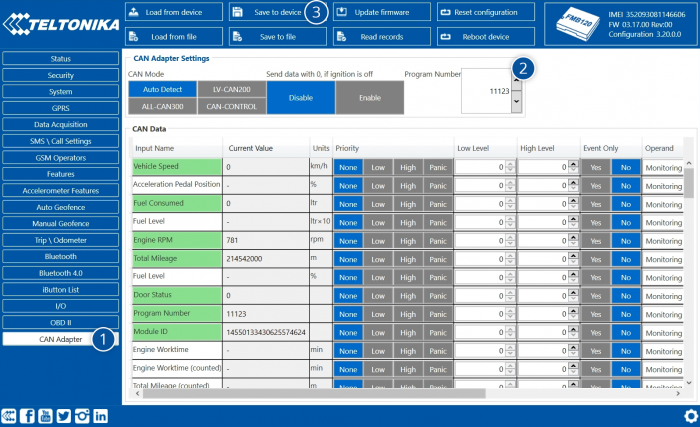
Entering manually
Required conditions:
- CAN adapter properly connected to FMU125 device
- Vehicle ignition must be ON
Depending on used CAN Adapter, length of setup sequence will vary.
Steps to set program number:
| For ALL-CAN300 LV-CAN200 3 digit |
For ALL-CAN300 LV-CAN200 4 digit |
For LV-CAN200 CAN-CONTROL 5 digit |
1. Hold SWITCH down until LED stars blinking. |
| 2. Release the SWITCH. | |||
| 3. Then LED starts blinking and counting first digit of program number (one blink means digit 1, two blinks mean digit 2 etc). To stop counter, push SWITCH. | |||
| 4. Release the SWITCH, then LED starts blinking and counting second digit of program number. To stop counter, push SWITCH. | |||
| 5. Release the SWITCH, then LED starts blinking and counting third digit on program number. To stop counter, push SWITCH. | |||
| 6. Release the SWITCH, then LED starts blinking and counting fourth digit on program number. To stop counter, push SWITCH. | |||
| 7. Release the SWITCH, then LED starts blinking and counting fifth digit on program number. To stop counter, push SWITCH. | |||
| All Devices | 8. Release SWITCH, if programming is successful LED will blink 10 times. | ||
FMU125 CAN Adapter parameters configuration
Teltonika Configurator
CAN Adapter configuration can be performed using Teltonika Configurator via Micro-USB cable or Bluetooth connection when CAN Adapter is connected to the vehicle.
When FMU125 is connected to the CAN Adapter, user can see all information that is received from the vehicle in Teltonika Configurator → Status → CAN Adapter tab or Teltonika Configurator → CAN Adapter section. In Status → CAN Adapter tab you can see information about CAN adapter and its readable parameters. In CAN Adapter section you can configure CAN Adapter and see incoming CAN bus data highlighted by green background color. Incoming data in both sections is automatically refreshed every 5 seconds. CAN bus data which should be readable from your vehicle is provided in "CAN Adapter supported vehicles list", which you can get from Teltonika Sales Representative.
The CAN Adapter I/O element can be configured like any other I/O element in Teltonika Configurator. All information about I/O element parameters description is in section I/O settings.
When using offline configuration method user can select which CAN data (according to vehicle) will be sent directly to the server without connection to adapter.
Send data with 0, if ignition is off
Depending on CAN Adapter I/O parameters and ignition status, FMU125 can send locked (last known) CAN Adapter I/O and active (real time) parameters values or reset values to 0. When ignition is off, CAN Adapter I/O parameters values sent to server are:
| CAN Adapter I/O element | Status |
|---|---|
| Vehicle Speed | reset |
| Accelerator pedal position | reset |
| Total fuel used | lock |
| Fuel level (liters) | lock |
| Engine RPM | reset |
| Total mileage | lock |
| Fuel level (%) | lock |
| Program number | lock |
| Module ID | lock |
| Engine Work Time | lock |
| Engine Work Time (counted) | lock |
| Total Mileage (counted) | lock |
| Fuel Consumed (counted) | lock |
| Fuel Rate | reset |
| Program number | lock |
| AdBlue Level (%) | lock |
| AdBlue Level (liters) | lock |
| Engine Load | reset |
| Engine Temperature | active |
| Axle 1 Load | lock |
| Axle 2 Load | lock |
| Axle 3 Load | lock |
| Axle 4 Load | lock |
| Axle 5 Load | lock |
| Control State Flags | active |
| Agricultural Machinery Flags | active |
| Harvesting Time | lock |
| Area of Harvest | reset |
| Mowing Efficiency | active |
| Grain Mown Volume | active |
| Grain Moisture | active |
| Harvesting Drum RPM | reset |
| Gap Under Harvesting Drum | active |
| Security State Flags | active |
| Tachograph Total Vehicle Distance | lock |
| Trip Distance | reset |
| Tachograph Vehicle Speed | reset |
| Tachograph Driver Card Presence | active |
| Driver1 States | active |
| Driver2 States | active |
| Driver1 Continuous Driving Time | active |
| Driver2 Continuous Driving Time | active |
| Driver1 Cumulative Break Time | active |
| Driver2 Cumulative Break Time | active |
| Driver1 Selected Activity Duration | active |
| Driver2 Selected Activity Duration | active |
| Driver1 Cumulative Driving Time | active |
| Driver2 Cumulative Driving Time | active |
SMS Configuration
All CAN Adapter IO elements can be configured remotely via SMS commands.
SMS/GPRS Commands
CAN Adapters have several dedicated SMS/GPRS commands.
SMS command structure:
<SMS login><space><SMS password><space><command><space><value>
SMS command lvcangetinfo example:
- If you have set SMS login and password:
login pass lvcangetinfo - If SMS login and password are not set leave two spaces before command:
aalvcangetinfo
GPRS commands require Codec 12 protocol.
For more SMS commands please see SMS/GPRS command list
| COMMAND | DESCRIPTION | RESPONSE |
|---|---|---|
| lvcansetprog # | Set program number to CAN Adapter that is connected to FMU125. # - three digit number that identity vehicle. |
Yes |
| lvcansimpletacho # | Add or remove simpletacho start byte. # - 0 or 1 (0 – don’t add start byte, 1 – add start byte). |
No |
| lvcangetprog | Get program number from CAN Adapter that is connected to FMU125. | Yes |
| lvcangetinfo | Get information about connected CAN Adapter | Yes |
| lvcanclear # | Clear Total Mileage (counted), Engine Work Time (counted), Fuel Consumed (counted) parameters values. # - parameter (0 – Engine work time (counted), 1 – Fuel Consumed (counted), 2 – Vehicle Mileage (counted)). |
Yes |
| allcanmode | Turn on ALL-CAN300 mode. | Yes |
| lvcanmode | Turn on LV-CAN200 mode. | Yes |
| lvcanfaultcodes | Read DTC fault codes | Yes |
| CAN-CONTROL specific commands | ||
| lvcanopenalldoors | Open [unlock] all doors | Yes |
| lvcanclosealldoors | Close [lock] all doors | Yes |
| lvcanopentrunk | Open [unlock] trunk | Yes |
| lvcanturninglights | One flash of all turn lights ordered trough accidental / blinking turn light switch | Yes |
CAN Adapter State Flags
CAN Adapters receive data about the states of various systems within the vehicle, and send them as flags to FMU125. FMU125 device stores these flags in hexadecimal format, as one variable. Bellow is a list of kept flags and how to retrieve them.
The full list of state flags is stored only by:
Only security state flags are stored by:
| Property name | Size, bytes | Value bitmasks |
|---|---|---|
| Control state flags | 4 | Byte0 (LSB): 0x01 – STOP |
| Agricultural machinery flags | 8 | Byte0 (LSB): 0x01 – Mowing |
| Security state flags | 8 | Byte0 (LSB): 0x01 – CAN1 not connected, require connection |
| Tachograph driver card presence | 1 | 0x00 – No driver card 0x01 – Driver1 card presence |
| Driver 1 states | 1 | 0xX0 – Break/rest 0xX1 – Availability |
| Driver 2 states | 1 |
LV-CAN200/ALL-CAN300 Important Information
Program Number logic change
Due to the growing number of supported cars, program numbers have exceeded "999". In order to maintain one number format, we are moving from 3-digit to 4-digit program numbers.
In new LV-CAN200/ALL-CAN300 firmware (from 2017-09-01) all program numbers that were up to 999 are changed to start from 1000. So that further program numbers would continue the counting with 4-digit numbers.
However, all existing program numbers stay the same, but "1" is added to the front. Device still understands the entered 3-digit program number (via SMS/GPRS), it will automatically add "1" before it. If you enter "247" - device number will turn into "1247". In Bootloader only 4-digit format is available, just add "1" to the front of the needed program number.
Example
When using older connection schemes where program number displayed as 3-digit program number:
Using LV-CAN200/ALL-CAN300 Bootloader from soft version 2017-09-27 it is necessary to add "1" to the front of program number:


